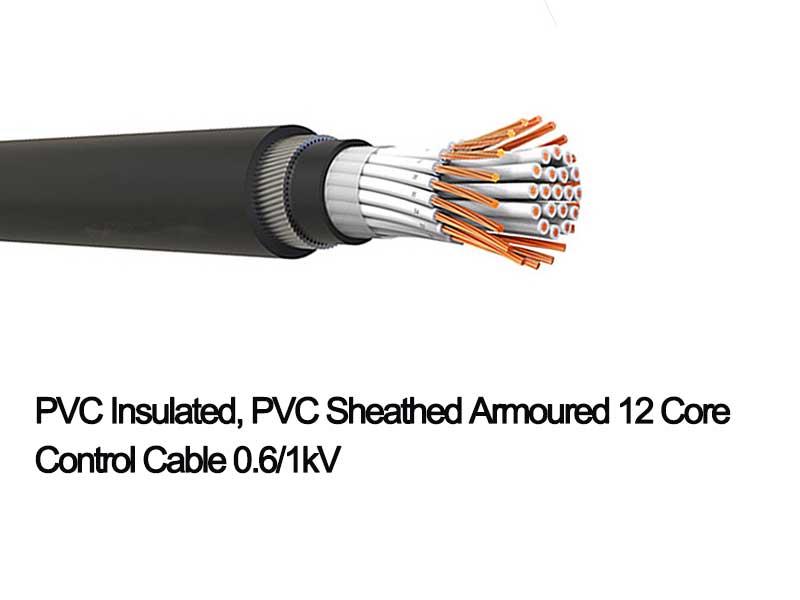SWA Control Cables
Uni-Cable's Steel wire armored control cables, also known as SWA control cables, are a type of control cable designed with an additional layer of steel wire armor for enhanced mechanical protection. Here are the specific specifications and application areas for steel wire armored control cables:
Specifications:Conductor: The conductors inside steel wire armored control cables are typically made of copper or aluminum. The choice of conductor material depends on factors such as conductivity requirements and cost considerations.
Insulation: These cables feature insulation layers made from materials like PVC (Polyvinyl Chloride) or XLPE (Cross-Linked Polyethylene). The insulation provides electrical separation between conductors.
Steel Wire Armor: The distinctive feature of these cables is the steel wire armor layer. This armor provides robust protection against mechanical damage, including crushing, impact, and abrasion. The steel wires are helically wound around the cable, forming a protective barrier.
Inner Sheath: Beneath the armor, there is typically an inner sheath that provides an additional layer of protection and helps maintain the overall integrity of the cable.
Shielding (Optional): Some steel wire armored control cables may include shielding layers to protect against electromagnetic interference (EMI) or radio frequency interference (RFI). This is crucial in applications where signal integrity is critical.
Outer Sheath: The outer sheath is made of materials such as PVC or other specialized compounds, offering protection against environmental factors, chemicals, and moisture.
Application Areas:Oil and Gas Industry: SWA control cables are commonly used in the oil and gas sector due to their ability to withstand harsh conditions, including exposure to chemicals and mechanical stress.
Mining: These cables find applications in mining operations where they are exposed to rugged environments and potential abrasion from rocks and debris.
Industrial Automation: SWA control cables are suitable for industrial automation systems where protection against physical damage is essential. They are often used to transmit control signals for machinery and equipment.
Construction: In construction sites, steel wire armored control cables are employed to ensure reliable communication in the presence of rough handling and environmental challenges.
Power Distribution: SWA control cables are used in power distribution systems to transmit control signals and maintain the integrity of communication, especially in outdoor or demanding conditions.
Renewable Energy: These cables are suitable for renewable energy installations, such as wind farms and solar power plants, where they may be exposed to outdoor elements.
Transportation: SWA control cables are used in transportation systems, including railways and airports, where they need to withstand mechanical stress and potential damage.
Standards:Several international standards govern the manufacturing and performance specifications of steel wire armored control cables. The standards ensure that these cables meet specific criteria related to materials, construction, and performance. When selecting steel wire armored control cables, it's essential to refer to the relevant national and international standards to ensure compliance with safety and performance requirements. Some of the key international standards for steel wire armored control cables include:
IEC 60502-1: This is an international standard developed by the International Electrotechnical Commission (IEC) that specifies requirements for power cables with extruded insulation and their accessories for rated voltages from 1 kV (kiloVolt) up to 30 kV. It includes specifications for armored cables, including those with steel wire armor, used in various applications.
BS 5467: British Standard 5467, published by the British Standards Institution (BSI), specifies the construction, dimensions, and performance requirements for steel wire armored power cables with extruded insulation for voltages up to and including 600/1000 V.
BS 6346: This British Standard, published by BSI, provides specifications for armored cables with thermosetting insulation for electrical power and control circuits. It covers a range of voltages and includes requirements for steel wire armored cables.
EN 50267: Part 1 of this European standard, titled "Common test methods for cables under fire conditions," specifies methods for testing the fire resistance of cables, including those with steel wire armor.
DIN VDE 0276-603: Published by the German Association for Electrical, Electronic & Information Technologies (DIN), this standard covers power cables with extruded insulation and their accessories for rated voltages from 1 kV up to 30 kV. It includes requirements for armored cables.
NEK 606: This is a Norwegian standard that specifies requirements for instrumentation, control, and communication cables used in offshore and marine applications. It includes specifications for cables with steel wire armor.
AS/NZS 5000.1: Part of the Australian/New Zealand Standard, this document specifies the requirements for armored cables with extruded insulation for power and control applications.
The steel wire armor makes these cables particularly durable and resistant to external forces, making them well-suited for demanding applications in various industries. As always, users should refer to product specifications and industry standards for accurate information on a particular cable's capabilities and suitability for a given application.
